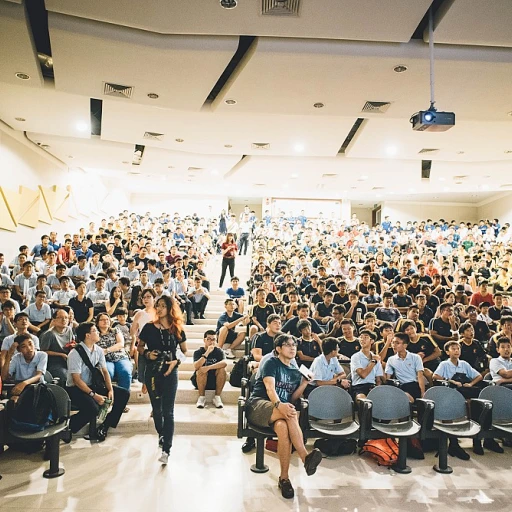
Understanding the Importance of Learner Interaction
Recognizing the Role of Interaction in Student Success
In today's ever-evolving learning environments, fostering effective interaction among learners is paramount. Interaction is more than just a buzzword in education; it serves as a critical component for achieving meaningful learning experiences. Whether in a traditional classroom or an online course, interaction enhances students' engagement and helps students develop essential communication skills.
Students thrive on social interaction, whether it involves discussions in a physical class setting or during online learning sessions. Effective communication between students and instructors, as well as among peers, facilitates a deeper understanding of course material and promotes active participation. When students feel connected to the content and their peers, their motivation to contribute and learn increases significantly.
Creating a learning environment that enhances social presence is essential to student success. It aids in developing a dynamic where students feel involved, respected, and motivated to engage with others. Teachers and instructors play a crucial role in this, using strategies and methods that foster interaction, such as group work and collaborative projects.
However, recognizing the role of interaction is just the beginning. Understanding and identifying the barriers to effective communication and engagement is equally vital. This not only aids in creating a conducive environment for learning but also strengthens the teacher-student relationship, ultimately enhancing the collective learning experience.
Identifying Barriers to Effective Interaction
Challenges in Creating Effective Student Interaction
Understanding the key barriers to interaction among students and teachers is pivotal in fostering a thriving learning environment. Barriers can manifest in various forms, stemming from both the educational setup and individual limitations.
One major hindrance is the absence of effective communication skills. When students lack the ability to engage in meaningful conversations, it affects their ability to collaborate and learn as a cohesive unit. Similarly, when teachers do not actively promote an open dialog within the class, students may feel isolated, which can hinder student interaction and social presence.
Additionally, the structure of a course, whether online or in a physical classroom, can impede interaction. Online learning environments often struggle to replicate the spontaneity and social interaction of a physical class, leading to a need for strategies that promote engagement and active participation. Moreover, large class sizes can limit the opportunity for individual interaction between students and instructors, reducing the overall effectiveness of communication.
In many cases, social relationships and diverse group dynamics might create an environment where some students hesitate to participate due to peer pressure or fear of criticism. Without a supportive setting provided by instructors, these dynamics can adversely affect the group work and discussions necessary for effective learning.
Finally, the traditional roles of teachers and students often create a resistance to active participation. Students accustomed to a passive reception of knowledge might find it challenging to shift towards a model centered around interaction and collaborative learning.
By addressing these barriers, educators can facilitate a learning environment where effective interaction is not only possible but thrives, thereby enriching the overall educational experience for students.
Creating an Inclusive Learning Environment
Creating a learning environment that fosters effective interaction among students is fundamental for the success of any educational program. To achieve this, several strategies need to be put in place, ensuring that interactions are both meaningful and inclusive.Designing a Welcoming Class Atmosphere
A welcoming class atmosphere is essential for the engagement and participation of all students. Teachers must work towards creating an environment where students feel comfortable expressing their thoughts and ideas without fear of judgment. This involves setting clear communication guidelines and encouraging mutual respect among students.Facilitating Social Presence
Social presence is crucial in both physical and online learning environments, as it helps students feel more connected to their peers and instructors. Instructors can facilitate social presence by encouraging personal introductions at the start of a course and promoting informal discussions both in and out of the classroom.Encouraging Group Work and Active Participation
Group work is an effective way to enhance social interaction. Assigning students to small groups can improve their communication skills and foster a supportive learning culture. Teachers should provide clear objectives for group tasks and encourage active participation within these groups to maximize the benefits.Promoting Effective Communication Skills
Effective communication is the backbone of successful interactions. Teachers can help students develop these skills by incorporating activities that promote listening, articulate speaking, and constructive feedback. Such skills are indispensable in nurturing the relationship between students and teachers, ultimately leading to a more dynamic learning experience.Building Connections Through Discussions
Facilitating discussions on various topics relevant to the course is a powerful tool in promoting effective student interaction. Discussions encourage students to critically think, articulate their thoughts, and engage with diverse perspectives. Instructors can guide these discussions to ensure that all students have the opportunity to contribute. Ultimately, creating an inclusive learning environment requires a proactive approach, combining various teaching strategies to accommodate the diverse needs of students. By doing so, teachers set the groundwork for effective interaction, which can significantly enhance the learning experience. More practical applications can be explored through real-world applications of competency-based training, further illustrating these principles.Leveraging Technology for Enhanced Interaction
Utilizing Technology to Improve Communication and Engagement
In today's digital age, leveraging technology is crucial to facilitate learning and encourage effective communication between students and instructors. Through various online platforms, students can engage in discussions, participate in group work, and improve their communication skills in ways that transcend traditional classroom settings. The use of technology in courses not only enhances interaction online but also allows for a more personalized learning experience. This virtual environment can offer students numerous opportunities to actively participate and engage with the coursework and their peers. Effective interaction is a key component that teachers can foster by integrating tools that complement teaching methods. Here are some strategies to enhance this process:- Interactive Forums: Platforms like online discussion boards can facilitate social interaction, enabling students to share ideas and feedback. This setting promotes the development of critical thinking and analytical skills.
- Video Conferencing Tools: Tools such as Zoom or Microsoft Teams allow for real-time engagement, conserving the essence of a live classroom setting. They can also accommodate group work, making it easier for students and instructors to collaborate regardless of location.
- Learning Management Systems (LMS): LMS like Moodle or Blackboard can streamline the educational process by providing centralized access to course materials, fostering better student interaction with content and classmates.
- Social Media Integration: Encouraging students to utilize social media can create an informal space for them to express their thoughts and connect with peers outside the conventional classroom.
Encouraging Peer-to-Peer Learning
Fostering Collaborative Learning
Encouraging peer-to-peer learning is a powerful strategy to enhance student interaction and engagement in both online and traditional classroom settings. When students actively participate in group work, they develop essential communication skills and social interaction abilities that are crucial for their academic and professional success.
Instructors can facilitate effective communication by creating opportunities for students to engage in meaningful discussions. This can be achieved by designing activities that require collaboration and problem-solving, which helps students build a strong relationship between themselves and their peers. By doing so, students feel more connected and supported in their learning environment.
Strategies to Encourage Peer Learning
- Group Projects: Assigning group projects encourages students to work together, share ideas, and learn from each other. This not only enhances their understanding of the course material but also improves their teamwork skills.
- Peer Reviews: Implementing peer review sessions allows students to provide constructive feedback to one another. This process helps students develop critical thinking and effective communication skills.
- Online Discussion Forums: In online learning environments, discussion forums can be an excellent platform for students to interact and exchange knowledge. Teachers can facilitate these discussions by posing thought-provoking questions and encouraging active participation.
- Study Groups: Encouraging students to form study groups can enhance their learning experience. These groups provide a space for students to ask questions, clarify doubts, and reinforce their understanding of the subject matter.
By providing these opportunities, teachers can create a dynamic learning environment where students are motivated to engage with one another. This not only enhances their learning experience but also prepares them for real-world scenarios where collaboration and communication are key.












